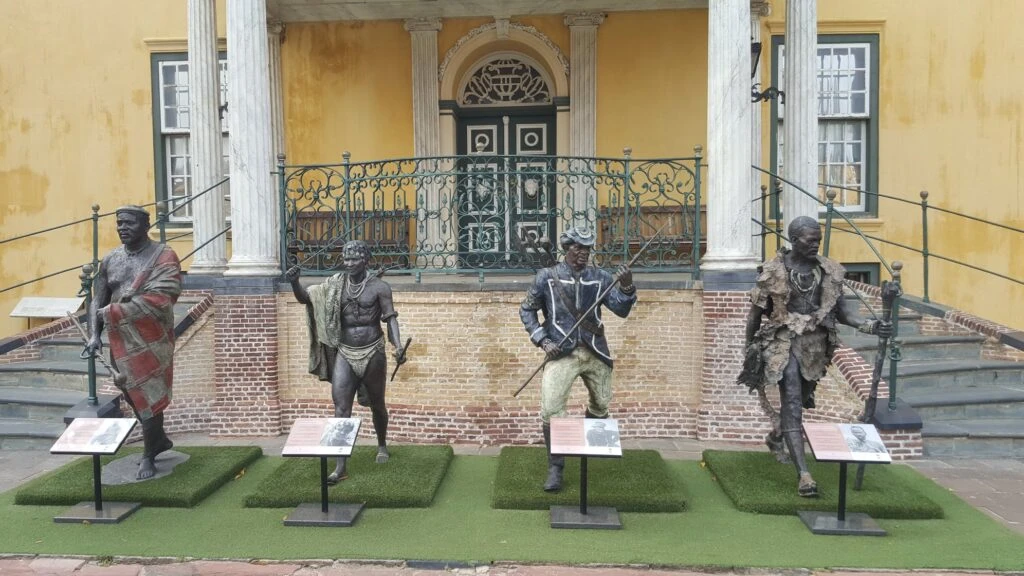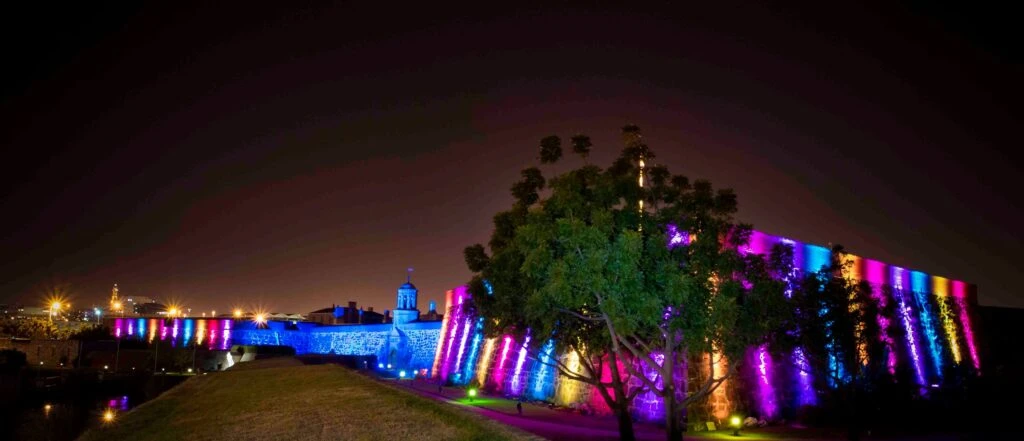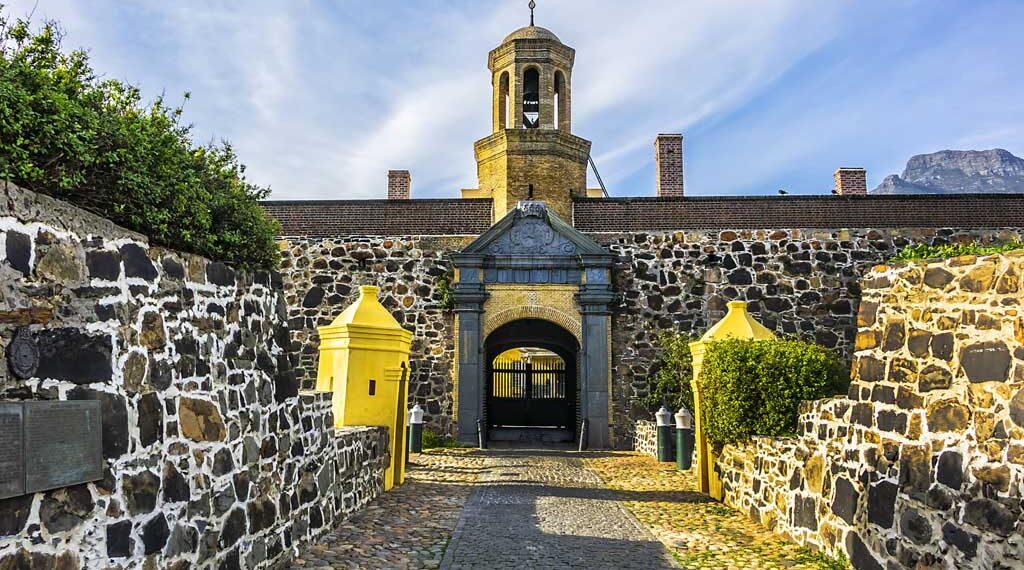Welcome to Cape Town, a city where every corner tells a story. One such historical tale unfolds within the robust walls of The Castle of Good Hope, a 17th-century bastion fort that is part of the city’s colonial past. We will explore everything you need to know, things to do at the Castle of Good Hope and what tickets are available for this iconic landmark.
Table of Contents
About The Castle of Good Hope 🧾


Situated in the heart of Cape Town, The Castle of Good Hope is the oldest existing colonial building in South Africa. Originally commissioned by the Dutch East India Company (DEIC) between 1666 and 1679, the Castle served as a strategic military installation to safeguard the interests of the Dutch in the Cape. Today, it proudly stands as a provincial heritage site, attracting thousands of visitors every year. As you step through the Castle’s gated entry, you’ll be transported back in time. The structure is a prime example of 17th-century architecture, with its distinctive pentagonal shape and well-preserved bastions.
Notable features include the iconic bell tower, which houses the oldest bell in South Africa, and the De Kat Balcony, providing breathtaking views of the surrounding cityscape. The Castle’s architectural style invites history enthusiasts and curious minds alike to explore its corridors and chambers. Throughout its history, The Castle of Good Hope has played many roles. Initially designed as a fortress, it later served as a prison during the Second Boer War and became the local headquarters for the South African Army. Today, the Castle continues to be a hub of activity, housing the Castle Military Museum and serving as ceremonial facilities for Cape Regiments, including the Cape Town Highlanders Regiment.
Things to do at The Castle of Good Hope 🎖


The Castle of Good Hope has a few things to take part in each giving a greater insight into the time period and the history of Cape Town. From a museum that has original tools, clothing and weapons from the colonial period, There are a few other parts of the castle that are still kept in their original state taking you back in time. When it comes to events and tours the Castle of Good Hope hosts a range of events throughout the year. These include cultural festivals, historical reenactments, art exhibitions, concerts, and educational programs. So let’s take a look at everything you need to know.
Castle Military Museum

Want to know more about South Africa’s military? The Castle Military Museum located within the Castle of Good Hope, offers an extensive collection of artefacts, weaponry, and exhibits that provide a comprehensive journey through the nation’s military past. From the echoes of colonial conflicts to the resounding achievements of modern times, the displays vividly portray South Africa’s military history with life-size exhibits.
The Castle hosts two more prestigious museums, The William Fehr Collection showcases fine examples of paintings and decorative arts, offering insights into the people and areas of early colonial South Africa. Meanwhile, the permanent ceramic exhibition, FIRED, housed in the historic granary, adds another layer to the Castle. Together, these museums invite visitors to delve into the diverse facets of South Africa’s heritage within the historic walls of The Castle of Good Hope.
Ceremonial Events and Tours

Get ready to be part of the action at The Castle of Good Hope with exciting ceremonial events that bring history to life. From the powerful beats of key ceremonies to the thunderous roars of cannon firings, these events show the military traditions that have left an indelible mark on South Africa’s legacy. You can also join one of the guided tours led by seasoned historians, unravelling the Castle’s hidden tales. These tours operate daily from 10:00 to 12:00 and resume from 14:00 to 15:00, offering a deeper understanding of the Castle’s history, architecture, and its crucial role in shaping Cape Town.
Don’t miss the spectacular cannon firings at 10:00, 11:00, and 12:00, performed by the skilled members of the Cannon Association of South Africa. Imagine the significance of each boom as it once signalled the sighting of a ship at sea, echoing through the fortress walls. You can also catch the captivating Key Ceremony at 10:00 and 12:00, witnessing the ceremonial guards unlock the Van der Stel entrance, a tradition carried from the past to the present adding a dynamic layer to your visit to The Castle of Good Hope.
Explore the Grounds

Walk through the Castle’s expansive grounds to get a feel for how life was back in the day and Don’t miss the chance to capture the amazing views of Table Mountain from the De Kat Balcony, it’s the perfect spot to snap a picture for Instagram on your visit to the castle. As you explore, make sure to drop by the Castle’s gift shop, a treasure trove of items supporting local artists and craft producers. It’s not just a shop; it’s a platform for small creative businesses to thrive, allowing visitors to take home a unique piece of Cape Town’s artistic spirit.
Pause to pay homage to Krotoa, an extraordinary leader of the Khoi nation, at the memorial located next to the Castle’s Chapel. This space commemorates her historical contribution, symbolizing resilience and strength. Feeling peckish? Head over to Re5 Restaurant, Located in the Castle’s front courtyard. Grab a coffee or some snacks and a light meal, Re5 also caters to Castle functions, conferences, and private events, ensuring you have something to drink and eat during your visit to The Castle of Good Hope.
Plan Your Visit to The Castle of Good Hope 📌


Planning a visit to the Castle of Good Hope is easy. The Castle is open every day of the week, and visitors can purchase tickets online or at the entrance. Guided tours are available, and visitors can also opt for an audio tour. The Castle is wheelchair accessible, and there are many parking options available. Visitors are advised to wear comfortable shoes and bring along sunscreen and hats as the Castle is an open-air attraction.
The Castle of Good Hope Opening Hours and Accessibility
Before planning your visit, be sure to check the Castle of Good Hope’s opening hours, which are now from 09:00 to 16:00. The accessibility of the Castle is facilitated by ramps and pathways, ensuring that visitors of all abilities can explore this historical gem. Additionally, guided tours are available for those seeking a more informed experience.
Safety Tips for Visitors
While Cape Town is a beautiful destination, it’s essential to be mindful of safety precautions. Visitors are advised to exercise caution, particularly when using ATMs. Downloading safety apps for emergency situations can provide an additional layer of security. Dont display your jewellery or cameras and make sure your phone and wallet are safe at all times as pickpockets are a problem, but remember to Stay informed and to enjoy your visit responsibly.
The Castle of Good Hope Ticket Infomation 🎫

To make the most of your visit to The Castle of Good Hope, it’s crucial to have information about the Castle of Good Hope ticket prices and available packages. Purchasing tickets online in advance is recommended to avoid queues and ensure a seamless entry into the Castle, Ticket sales close each day at 3:15 pm. Here’s a breakdown of the ticket options:
- Standard Admission: Adults – R50, Children (5-16 years) – R25
- Family Package: 2 Adults + 2 Children – R120
- Guided Tour: Additional R20 per person
- School Groups: Special rates available, contact in advance for bookings
- Military Museum Only: R30
Address: Darling St & Buitenkant St, Cape Town, 8001
Website:https://www.castleofgoodhope.co.za/
Contact Number: 021 787 1249
The Castle of Good Hope really brings together the soul of Cape Town, being able to travel through time and experience a tale of resilience and transformation is one you won’t want to miss and it’s a low-cost activity to do in Cape Town. From its beginning as a Dutch fortress to its current status as a cultural hub, the Castle invites visitors on a journey through centuries of history. Whether you’re a history buff or a casual explorer, the Castle’s architecture, educational exhibits, and iconic look create a unique experience. As you plan your visit, let the stories etched in its walls captivate you, and take part in events that breathe life into history.






